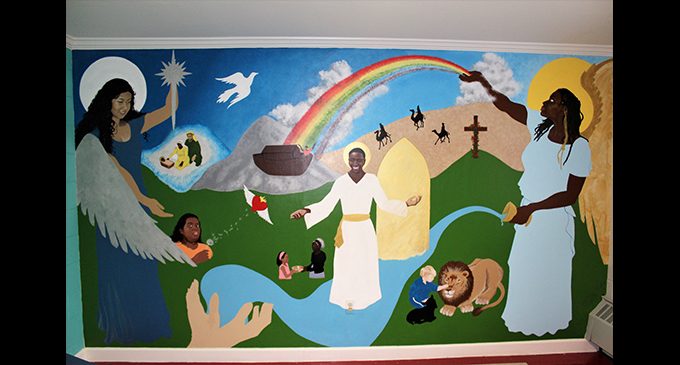Artist’s mural sparks conversation into a deeper issue
Carol Ann Krebs painted a mural depicting a black Jesus to spark discussion between the races.

Carol Ann Krebs is an accomplished artist who set out on a mission prior to her most recent work. The project was a mural and her goal was to spark conversation about the elements of the piece.
Some may be wondering what could spark so much conversation about a mural. In the mural, Krebs depicted several Biblical scenes, but the most prevalent part of the piece would have to be the black Jesus posted right in the middle of the mural. She also used different races to depict other Biblical characters, such as Mary, Joseph and Noah.
The mural was a project Krebs did for Christ Beloved Community Church, 3205 S. Main Street in Winston-Salem. She wanted to change the narrative of how black people are viewed or treated in the church.
“The mural started as a much simpler idea, but became increasingly more complex as I worked on it,” said Krebs. “I don’t know that Jesus was black, but I know he was not white, because he was a Jew in ancient Palestine. I figured there were enough white Jesuses running around that even if historically Jesus isn’t black, we need a few to balance things out.”
Krebs, who is white, said she wanted to use visual arts to challenge racism in the church. Her goal was to “affirm people of color in religious art, because they are traditionally not there.” Krebs’ other goal was to “make white people stop and think, because we sort of take things for granted.”
“What I tell people is that maybe if we see a black man as the source of our salvation instead of a threat, it will shift the way we look at things,” she said. “A lot of it originally was just I wanted people who never see themselves on the wall to come in and look up there and see themselves.” She hopes they say ‘I’m beautiful.’
She used real people to serve as models for the characters in the mural. Her thought was if she used real people, it would inspire us to “look for God in the people around you.”
“I thought if I keep changing Jesus and he is based on a real person, then any black man you see could be Jesus,” she continued.
Krebs said she felt the mural would have more impact if she based the figures in the painting on real people, because the church is named Christ Beloved Community and the community is all around us.
Another aspect of the piece Krebs wanted to focus on was the stereotypes about beauty. She used people with different body types to show beauty comes in all shapes, sizes and colors.
“I was trying to get as many ethnicities in there as I could and the imagery in there was all intentional,” she said. “I also wanted white people to look up there to see people of color as holy and divine.”
Krebs and the church decided to go with Biblical images rather than having one scene. She felt it would allow viewers to “see what they needed to see” whenever they looked at the mural.
“I wanted it to meet people’s needs,” she said about the mural. “Part of why I painted it and what I wanted to do with the art was to start the dialogue. Part of what I have learned in my steep learning curve over the last two years is, when white people get together to talk about race, we talk about ourselves.
“I wanted this to generate conversation and I know what I had in mind when I did it, but I think it means more to the community of color than I realized. I think that white people will look at it and look at it as art, black people will get it as a social statement. I meant it as a social statement, but I don’t know that even yet, because I am white, what it means to different people in the community.”
Some of the reactions from white people to the mural have been interesting and sad, said Krebs. “To be honest with you, some of the ones that would have been considered more racist reactions, I’m more comfortable with, because we can talk. If somebody comes in and their whole focus is on what a good job I did on the sand, I get a little twitchy. If people are focusing on it only as an artform, they are either more ignorant than they want to admit, or they are uncomfortable and they don’t want to admit it.”
It was surprising to Krebs that many white individuals are not willing to touch on the racial aspect of the mural. She expected that many of her “liberal” friends would be willing to have an open dialogue about it, but was surprised when they did not.
Krebs began her work on the mural in the beginning of August 2018 and finished it in early February. This is the first time she has tackled a project of this size, but was pleased with the overall outcome. She has other projects she would like to pursue in the future and hopes they continue to press the issue of discussion to bring more equality to people of color and a better understanding from white people.










